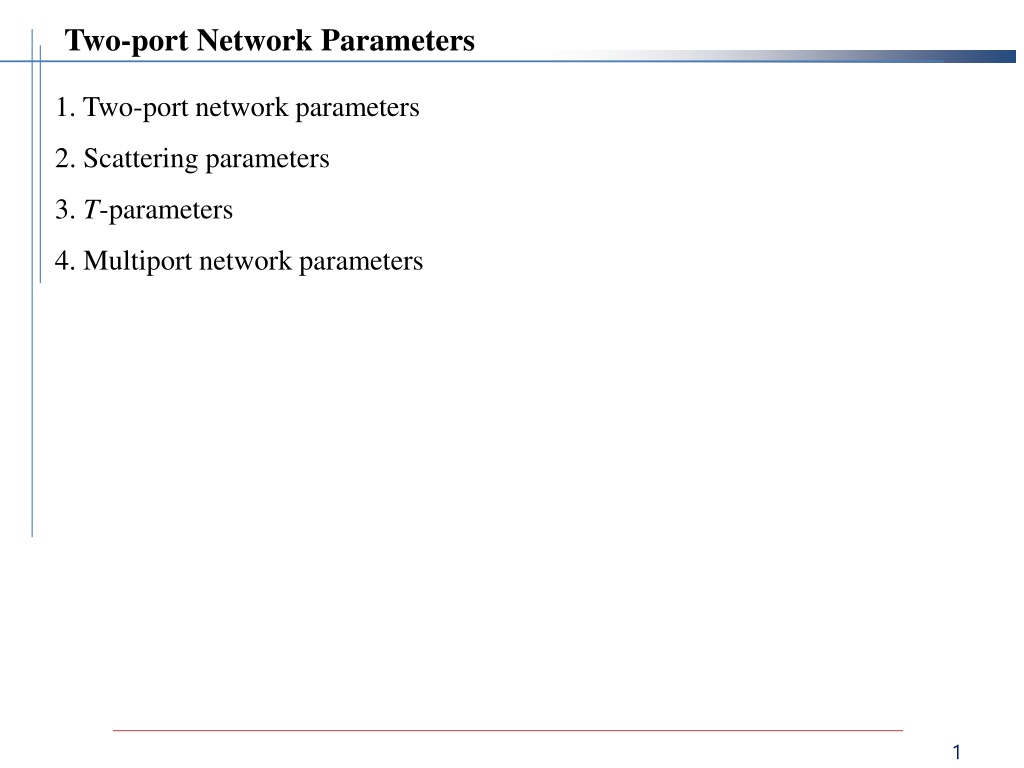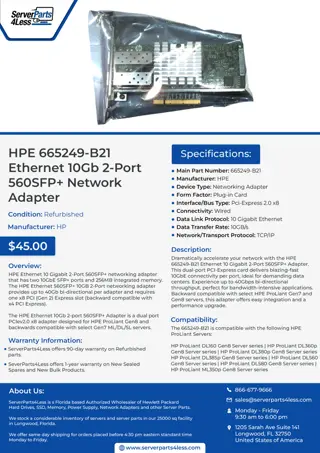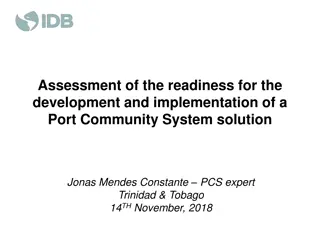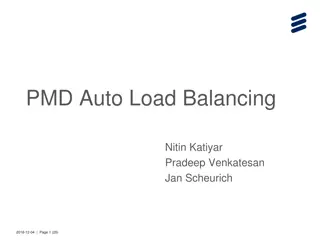
Understanding Two-Port Network Parameters and Conversions
Delve into the realm of two-port network parameters including impedance, admittance, a-parameters, b-parameters, h-parameters, g-parameters, and parameter conversions. Explore the definitions, complexities, and applications of these network parameters for low-frequency circuits, transmission, and cascading. Unravel the intricacies of network analysis through a diverse range of parameters and their significance in understanding network behavior and design.
Download Presentation

Please find below an Image/Link to download the presentation.
The content on the website is provided AS IS for your information and personal use only. It may not be sold, licensed, or shared on other websites without obtaining consent from the author. If you encounter any issues during the download, it is possible that the publisher has removed the file from their server.
You are allowed to download the files provided on this website for personal or commercial use, subject to the condition that they are used lawfully. All files are the property of their respective owners.
The content on the website is provided AS IS for your information and personal use only. It may not be sold, licensed, or shared on other websites without obtaining consent from the author.
E N D
Presentation Transcript
Two-port Network Parameters 1. Two-port network parameters 2. Scattering parameters 3. T-parameters 4. Multiport network parameters 1
1. Low-frequency Network Parameters Port voltage and current definition Two-port network parameters - Select 2 variables out of 4 variables (V1, I1, V2, I2) - 4C2 = 6 cases z (impedance) parameters y (admittance) parameters a parameters b parameters h parameters g parameters 2
a-parameters (1) - Other names: ABCD-parameters, chain (cascade, transmission) parameters 7
a-parameters (2) - ABCD-parameters of simple networks 8
b-parameters (1) - Inverse ABCD-parameters 9
b-parameters (2) - Inverse ABCD-parameters of simple networks 10
h-parameters (2) - Example: CB-amp 12
g-parameters = Inverse hybrid parameters (2) - Example: CB-amp 14
4. Multiport Network Parameters Multiport networks - 3-port: circulator, power divider, mixer - 4-port: hybrid coupler, directional coupler, magic T junction Network parameters for multiports y-parameters z-parameters s-parameters 23
Maximum power transfer for AC networks Z + R + 1 + * S 2 L L = = = Re( *) Re | | P V I V V V L L S S * 2 2 + + Z Z ( ) ( ) ( ) Z Z R R X X S L S L S L S L P R P X L L = = = = 0 and 0 and R R X X L S L S L L 2 V 1 2 1 2 S = = = = P P P V I ,max L L S S 4 R S = + P P P S R R S L 24
3. Scattering Parameter Scattering parameter, S-paramter - Lossless networ: unitary condition - Reciprocal network: = S S mn nm 25
Scattering parameters of simple networks - Transmission line l j 0 e = [ ] S l j 0 e - Series element on transmission line Z Z Z Z Z S Z Z Z Z Z + + + Z Z 0 + + 2 2 0 0 Z = [ ] 0 + 2 2 Z 0 0 - Shunt element on transmission line 2 Y Y + 0 + 2 2 Y Y Y Y 0 0 = [ ] S 2 Y Y + 0 + 2 2 Y Y Y Y 0 0 26
4. Conjugate Matching Maximum power transfer theorem for two-ports - S. D. Stearns, ARRL Pacificon Antenna Seminar, 2011 * (conjugate matching) s = Z Z L * s * L = = (simultaneous conjugate matching) Z Z Z Z out in 27
Two-port matching network design [www.ittc.ku.edu/~jstiles/723/ - Find the equivalent circuit at the output of the two-port network using the open-circuit and short-circuit method. - Design a two-port network for the conjugate matching at the load. * L = Z Z out 28
5. Impedance Matching of Two-port Networks Two-port network power gains [S] : scattering parameters are defined with Z0. 30
- Power gain G: source & load not matched - Available power gain GA: source & load matched - Transducer power gain GT: source matched, load not matched G G G T A - Gain in dB: G (dB) = 10log10G 32
Two-port network power gains with conjugate matching = max( ) P P in avs * S * S = = : maximum if or P Z Z in in in = max( ) P avn P L * out * out = = : maximum if or P Z Z L L L 33
Example 35
Input and output matching of two-port networks 2 1 2 2 4| | B B C 1 1 = s C 1 2 2 2 4| | B B C 2 2 = L 2 C 2 37
+ 1 1 S = S Z Z S S + 1 1 L = L Z Z L L Input matching network: ZS Z'S Output matching network: ZL Z'L 38
Example - With Z0 = ZS = ZL = 50 39
6. Coding Example Two-port network input & output matching - Input data: System reference impedance Z0 ( ) Source impedance ZS ( ) in real/imaginary form Load impedance Z2 ( ) in real/imaginary form Two-port scattering parameters S11, S21, S12, S22 in polar or rectangular form - Output results: Transformed source and load impedances: ZS', ZL' in ohms Power gain G in natural and dB units Available power gain GA in natural and dB units Transducer power gain GT in natural and dB units 40
# Two-port network input & output matching # Input data: # System reference impedance z0 # Source impedance (zs), load impedace (zL) in real/imaginar format # Scattering parameters (s11, s21, s12, s22) in polar form (magnitude in natural unit, phase in degrees) # Output results: # Transformed source impedance zs' in ohms # Transformed load impedance zL' in ohms # Power gain g, available power gain ga, transducer power gatin gt in dB import cmath import math rad=3.141593/180 while True: imatch=int(input('Calculate transformed input and output impedances?(0,1)=')) ipolar=int(input('S-parameter form(1:polar, 2:real/imaginary)')) z0=float(input('System reference impedance Z0 (ohm) =')) rs,xs=map(float,input('Source impedance Zs=Rs+jXs (ohm): Rs, Xs =').split()) zs=complex(rs,xs) rL,xL=map(float,input('Load impedance ZL=RL+jXL (ohm): RL, XL =').split()) zL=complex(rL,xL) 41
if ipolar == 1: s11m,s11p=map(float,input('Mag(S11), phase(S11)(deg) =').split()) s12m,s12p=map(float,input('Mag(S12), phase(S12)(deg) =').split()) s21m,s21p=map(float,input('Mag(S21), phase(S21)(deg) =').split()) s22m,s22p=map(float,input('Mag(S22), phase(S22)(deg) =').split()) s11=cmath.rect(s11m,s11p*rad) s12=cmath.rect(s12m,s12p*rad) s21=cmath.rect(s21m,s21p*rad) s22=cmath.rect(s22m,s22p*rad) elif ipolar == 2: s11r,s11i=map(float,input('Re(S11), Im(S11) =').split()) s12r,s12i=map(float,input('Re(S12), Im(S12) =').split()) s21r,s21i=map(float,input('Re(S21), Im(S21) =').split()) s22r,s22i=map(float,input('Re(S22), Im(S22) =').split()) s11=complex(s11r,s11i) s12=complex(s12r,s12i) s21=complex(s21r,s21i) s22=complex(s22r,s22i) gs=(zs-z0)/(zs+z0) # Source reflection gL=(zL-z0)/(zL+z0) # Load reflection gin=s11+s12*s21*gL/(1-s22*gL) # Input reflection looking into port 1 of the two-port network gout=s22+s12*s21*gs/(1-s11*gs) # Output reflection looking into port 2 of the two-port network 42
g=abs(s21)**2*(1-abs(gL)**2)/(abs(1-s22*gL)**2*(1-abs(gin)**2))g=abs(s21)**2*(1-abs(gL)**2)/(abs(1-s22*gL)**2*(1-abs(gin)**2)) ga=abs(s21)**2*(1-abs(gs)**2)/ (abs(1-s11*gs)**2*(1-abs(gout)**2)) gt= abs(s21)**2*(1-abs(gs)**2)*(1-abs(gL)**2)/ (abs(1-s22*gL)**2*abs(1-gs*gin)**2) print(' Power gain G =',g,'/',10*math.log10(g),'(dB)') print(' Available power gain Ga =',ga,'/',10*math.log10(ga),'(dB)') print(' Transducer power gain Gt =',gt,'/',10*math.log10(gt),'(dB)') if imatch == 1: d=s11*s22-s12*s21 dm=abs(d) # abs() function returns absolute values for integer, real, and complex numbers k=(1-abs(s11)**2-abs(s22)**2+abs(d)**2)/(2*abs(s12)*abs(s21)) b1=1+abs(s11)**2-abs(s22)**2-abs(d)**2 b2=1+abs(s22)**2-abs(s11)**2-abs(d)**2 c1=s11-d*s22.conjugate() # complex class conjugate function c2=s22-d*s11.conjugate() gsp=(b1-math.sqrt(b1**2-4*abs(c1)**2))/(2*c1) # Transformed source reflection gLp=(b2-math.sqrt(b2**2-4*abs(c2)**2))/(2*c2) # Transformed load reflection zsp=(1+gsp)*zs/(1-gsp) zLp=(1+gLp)*zL/(1-gLp) print(' Transformed source impedance: Zg =',zsp) print(' Transformed load impedance: ZL =',zLp) 43
''' Calculate transformed input and output impedances?(0,1)= 1 S-parameter form(1:polar, 2:real/imaginary) 2 System reference impedance Z0 (ohm) = 50 Source impedance Zs=Rs+jXs (ohm): Rs, Xs = 50 0 Load impedance ZL=RL+jXL (ohm): RL, XL = 50 0 Re(S11), Im(S11) = 0.5998 -0.5399 Re(S12), Im(S12) = 0.0675 0.0373 Re(S21), Im(S21) = -0.2194 1.1418 Re(S22), Im(S22) = 0.1166 -0.4004 Power gain G = 3.876276835462403 / 5.8841478587625 (dB) Available power gain Ga = 1.6364475547216564 / 2.139020914894498 (dB) Transducer power gain Gt = 1.3518436 / 1.3092644930828499 (dB) Transformed source impedance: Zg = (32.59169632182722+112.80182946859793j) Transformed load impedance: ZL = (30.386211590971747+29.502492322691676j) 44
Calculate transformed input and output impedances?(0,1)= 0 S-parameter form(1:polar, 2:real/imaginary) 1 System reference impedance Z0 (ohm) = 50 Source impedance Zs=Rs+jXs (ohm): Rs, Xs = 25 0 Load impedance ZL=RL+jXL (ohm): RL, XL = 40 0 Mag(S11), phase(S11)(deg) = 0.38 -158 Mag(S12), phase(S12)(deg) = 0.11 54 Mag(S21), phase(S21)(deg) = 3.50 80 Mag(S22), phase(S22)(deg) = 0.40 -43 Power gain G = 13.085822887992618 / 11.168010379791545 (dB) Available power gain Ga = 19.83537106617267 / 12.974403293619135 (dB) Transducer power gain Gt = 12.603900024194017 / 11.005049496342165 (dB) Calculate transformed input and output impedances?(0,1)= ''' 45






















